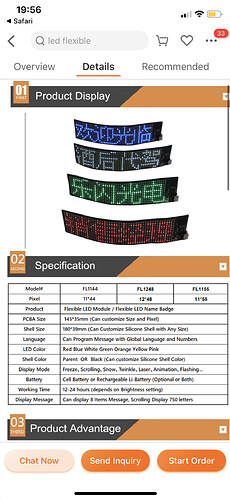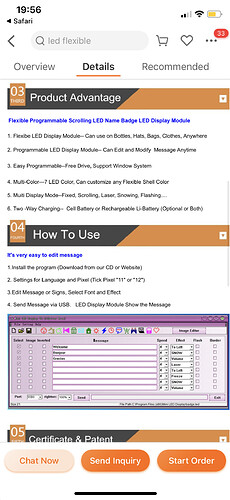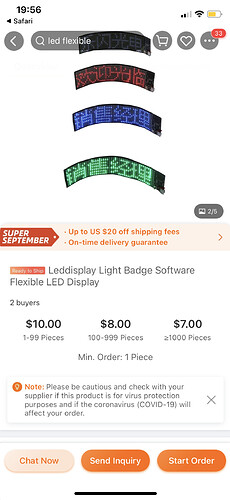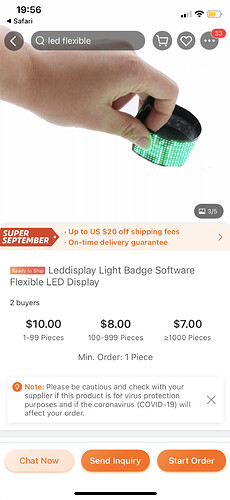I know we have implants that feature a small number of LEDs already. But groups like [Roger’s research group](https://Implantable LEDs. How far from consumer availability?) have been (Seemingly) successful in creating an array of LEDs that would be suitable for sub-dermal implantation. I’m thinking purely for cosmetic purposes - Think LED tattoo -. How close to a consumer market is this type of mesh array? Or for amal to implement something similar?
And when it comes to other tech, Roger’s has already released publications regarding sweat sensing analytic devices that seem very exciting. I hope to continue to be a part of this “Body upgrading” movement and seeing others make advancements that can be learned from or used is very exciting.
The answer is never, unless someone makes it ![]() . Are you willing to help make that a reality, or did you just want to know when it will be available of the shelf? I know several forum members who would also be willing to commit to some kind of underskin display. We could make a Community Project for it.
. Are you willing to help make that a reality, or did you just want to know when it will be available of the shelf? I know several forum members who would also be willing to commit to some kind of underskin display. We could make a Community Project for it.
A genuine display with color is going to need a lot of power, so you’re probably talking about Qi charging, which means carrying around equipment. Would it still be worth it then? Even with the largest viable implantable battery (which we don’t do here for now) I could see maybe 2000maH. If each pixel is drawing about 10mA and you had a 64*32 display, we’re talking 20.5A continuous current draw. That means even a huge unsafe 2000mAh battery would only last 6 minutes.
Amal and I have been kicking around the idea of an e-ink tattoo for awhile now. I haven’t had the bandwidth/capital to properly explore capacitive coupling through the skin. It’s a longshot
That would be a great to have a community project! Of course I would be willing to contribute in whatever way I could.
I actually have an idea regarding power supply that I haven’t seen suggested yet. I’m just getting off work so I’ll need some time to draw out a quick sketch and I’ll post here when I get a more concrete idea of if it will even be viable haha.
Curious, would this (hypothetically) be like actual conductive ink applied in the same manner as a tattoo?
Probably not. It would be more like a flexible plate installed with a region of encapsulated viscous fluid containing the ink, and the other plate would be external to the body whenever you wanted to change the image
There are mm thin LED arrays that are commercially available. I just ordered one to test heat/thickness/flexibility. These arrays (or ones like it) can be programmed and powered with little energy requirement.
This brings me to the idea of sub-dermal anchors. These are commonly used already and are a titanium support with a hollow post for screwing in jewelry. If this post were to be hollowed out, wiring could be fed through the post to reach the LED circuit. This access through the post could be filled with silicone to close up the access point and then a button battery could be screwed onto the post in place of jewelry to power the LEDs. The LED array itself could be housed in a bio polymer “Pocket” that the dermal anchor is connected to/ the bottom placed inside of.
This is all rough and I have no idea if it would work practically but I have purchaced the LED array and will be buying some dermal anchors.
I have no clue about wiring/power/electrical but I am hoping others might or I will be able to learn.
Having the battery external removes a large risk of corrosion or overheating. This way, the battery can be exchanged as it is depleted or removed altogether in a case of failure, overheating, or other emergency. The safety factor has an established history as people have used dermal anchors with good success for a while now, and the FLEX line of Dangerous things products, as well as other silicone implants show that the larger footprint should be doable as well (Or at least scaled back). Having the LED array as well as the wiring from the circuit to the battery encased in a biosafe material such as silicone will seal off any opening from the skin while still allowing a battery to be placed and removed in the same manner as a jewelry item.
Additionally, when it come to resources what I’m lacking is more knowledge and experience rather than capital. I would be willing to donate/invest in this project if the minds here saw any potential fruit in it.
@rexdeanrds you should do some searching on biohack.me for this stuff. Why it would be difficult has been explored and explained at least a dozen times before.
I’m not trying to stifle innovation, because it could potentially be done. You should just accumulate a baseline of knowledge before you actually pursue something like this, so we’re not retracing our steps endlessly.
On the topic of e ink,
I wonder if it’s possible to flip particles without the. Electrodes, but rather e ink particles in say tattoo ink
I think a much lower hanging fruit, but still fun goal would be a regular tattoo design of whatever flavor you like, that you can flip from “normal” to a white “subtle” mode
Next rung up might be tattooing an area, and then rigging up a stylus that can flip particles, ala magna doodle
Lots of people have wanted that to be a thing, because it’s a cozy idea. Functionality though you’re going from the suspension medium being an electrically isolated low-viscosity fluid, to a very electrically active semi-solid flesh.
Amal and I have talked it over and the only path we see actually working is a fully encapsulated implant, and even that is a heavy maybe as the necessary install depth may preclude visibility
I still have questions about the ink’s actual behavior in a magnetic field. Can anyone actually get ahold of some for analysis?
I wasn’t aware of this site. I will do some digging. Thank you!
Np m8. I figured teach a man to fish. Not trying to shut you down or anything.
Looking around now but most posts seem very dated. At the risk of rehashing something that has been discussed before. What are the major failure points of the LED matrix with external battery design? Is it anything that can be worked around at all or is it off the table entirely?
Physics hasn’t changed much in the few years since biohack.me was active. Transdermal implants still get very aggravated if you suspend any weight whatsoever off of them, batteries still emit gases that compromise biocompatible encapsulation, and LEDs can still be powered more easily from a magnetic field than from a physical wire
All great notes, thank you for the reply. I will do what I can to keep informed!
I believe it is possible to get hold of some small e-ink displays but I don’t know if you can get hold of just the e-ink itself.
I see the displays used for shelf displays in the local supermarket every now and again. I’m always tempted to just add one to my shopping and see what the checkout staff do. ![]()
ETA: I have found some displays on Alibaba for $6 plus $11 shipping. This product is no longer available. if you’re interested in testing these I can order a few.
To follow up on this, eink themselves have a few flexible options available from their catalog as well. Including this 0.621mm thick flex version. As well as this 0.77mm thick low voltage flexible model.
@Zwack - Same goes here, I would be willing to either make a donation or attempt to secure an order if this would be something you are interested in testing.
I had three microdermal implants like the ones you posted here, for about eight years. Lemme tell you this - it’s not really possible to get them to heal. It’s always an open pocket in the skin, and it tends to get inflammated really, really fast. Anything that goes through skin is a problem.







